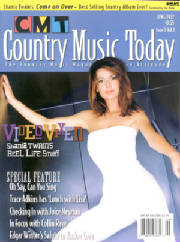|

CMT
Her first-ever single collection boasts an impressive (OK, make that exhausting!)
21 tracks and features three new cuts, including two versions of "Party for Two" (one with labelmate Billy Currington and
another with Sugar Ray frontman Mark McGrath. There's also one titled "I Ain't No Quitter." Grammar aside, this one sounds
like a winner!
BLENDER MAGAZINE
Blockbuster hits set from the best pop singer since Madonna
Reviewed by
Rob Tannenbaum
She came from Canada, had a first name no one could pronounce, and her first album was about as popular
as a tax increase. Ten years ago, Shania Twain was no one’s choice to conquer the country charts and then become the
top-selling female singer of all time. So when it happened, much of the credit went to her belly button, which was photographed
so often it could’ve had a solo career. But this spectacular compilation of her last three albums, plus four worthy
new songs, shows Twain’s real innovation: turning Southern music from the subject of divorces and funerals to weddings.
“I
know I sound serious,” she coos in “I’m Gonna Getcha Good!” which is the grandest deception since
Madonna declared herself a material girl. Twain is a sentimentalist and her songs are silver linings - the alliteration
and exclamation points are there to mark her flirty, goofy enthusiasm. The melodies are so luxurious, they’re like 400-thread-count
overalls, and the music lives in an untroubled world: “Up!” a song title, is the only direction she knows, and
her masterpiece ballad, “You’re Still the One,” regards marriage as one long honeymoon night.
But
Twain also connects with more female listeners than any sex object ought to because she demands that her generosity be reciprocated
with devotion: “Any man of mine better walk the line,” she demands. She likes sex, but she also requires commitment,
which is the most Nashville thing about her.
In her mission to fill country with impurities and fun, she’s joined
by her husband, producer and cowriter Mutt Lange, who had taken the Cars and Def Leppard to the top of the world. Twain is
clearly a modern woman - she complains about PMS in “Honey, I’m Home” - and by adding new-wave
drums and rock guitars, she crosses borders in a confusing and exciting way. If this music isn’t country, what’s
with the fiddles and the songs about boots? And if it is country, why does the music sound best shouted from hockey arenas,
not played on back porches?
|

